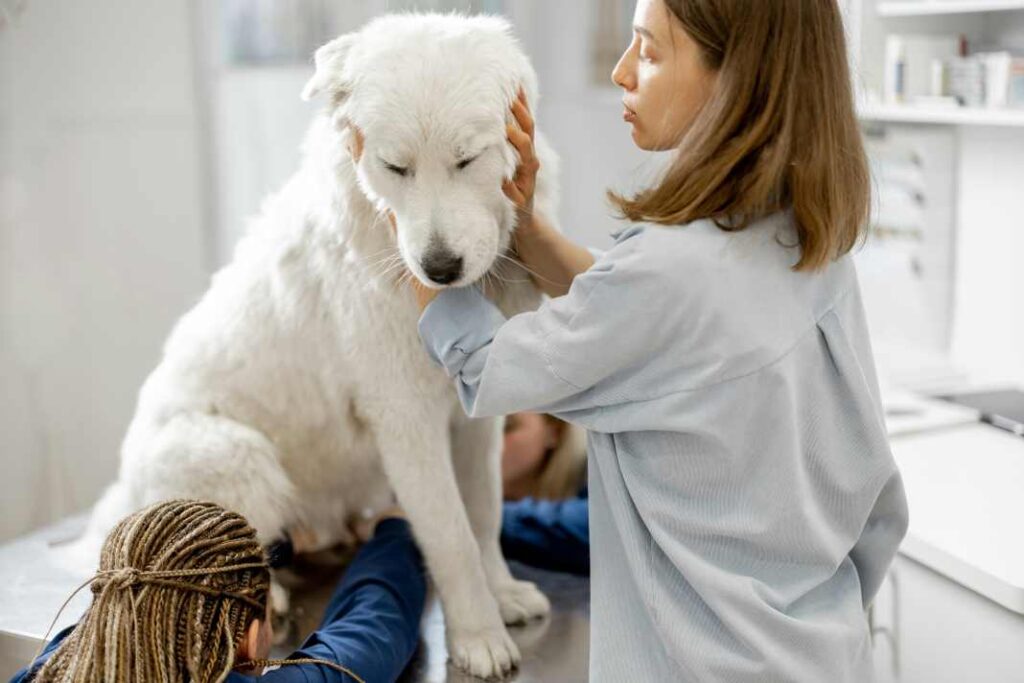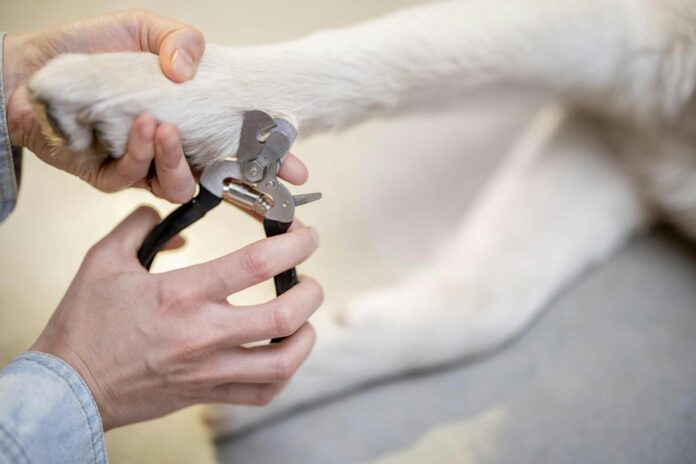Explore alternative dog nail care and trimming methods that provide a less stressful experience, including the use of a Dremel tool, manual filing, innovative nail filing tools like the DiggerDog Nail File, and the Alternative Cut Line (ACL) method, with tips on managing mishaps such as hitting the quick.
Exploring Alternative Nail Trimming Methods for Dogs
Navigating the task of nail trimming can be a daunting experience for both dog owners and their pets. The traditional approach of using nail clippers often incites fear and stress in dogs, making the process challenging and unpleasant.
This adversity stems not only from the physical sensations associated with clipping but also from the anxiety-inducing sounds and the potential for painful mishaps, such as clipping the quick.
For some dogs, like the case of Sokka, a 6.5-month-old puppy, this fear can be overwhelming, leading to an extreme aversion to nail clipping despite efforts at desensitization and positive reinforcement. This scenario highlights the critical need for alternative nail-trimming methods that prioritize the comfort and safety of our canine companions.
Exploring gentle nail trimming methods like Dremel tools and files can make the process less stressful for dogs, prioritizing their comfort.
The quest for less stressful nail maintenance solutions has opened up a discussion among dog owners and professionals about innovative and gentle methods. These alternatives range from using specialized tools to adapting grooming techniques that align more closely with a dog’s comfort level. The goal is to transform nail trimming from a dreaded chore into a manageable, if not entirely pleasant, routine for dogs and their owners alike.
As an Amazon Associate, I earn from qualifying purchases. When you purchase products through the links on this page, I may earn a small commission at no extra cost to you.
By exploring options beyond traditional clippers, such as the Dremel tool, manual filing, or the innovative DiggerDog Nail File, dog owners can find a method that best suits their pet’s temperament and needs, ensuring the maintenance of their nail health without the drama.
This shift towards gentler, fear-free grooming practices underscores the importance of understanding our pets’ perspectives and adapting our approaches to meet their emotional and physical well-being.
Understanding Dog Nail Anatomy and the Importance of Regular Trimming
The anatomy of a dog’s nail is complex, and understanding it is essential for proper grooming. The nail consists of a hard outer shell and a sensitive inner part known as the quick, which contains blood vessels and nerves.
Trimming a dog’s nails without understanding where the quick ends can result in pain and bleeding, which can make the dog fearful of future nail trims.
Regular nail maintenance is crucial not just for the dog’s appearance but for its health and well-being. Overgrown nails can change the way a dog walks, leading to discomfort and potentially causing joint problems or injuries over time.
Understanding dog nail anatomy is key to safe trimming, preventing pain, and promoting health. Regular maintenance avoids overgrowth and related issues.
Moreover, nails that are too long can get caught on fabrics or carpets, increasing the risk of painful breaks or tears.
The importance of regular nail trimming cannot be overstated. It prevents the quick from growing too long, which can make subsequent trims more challenging and potentially painful. A dog with appropriately trimmed nails will have better posture and gait, reducing the risk of developing musculoskeletal issues.
For many dog owners, the process of trimming their dog’s nails can seem daunting, particularly with the fear of cutting the quick. However, with a proper understanding of nail anatomy and the use of the right tools and techniques, owners can perform this grooming task with confidence, ensuring their dog’s comfort and health.
Tools like the Alternative Cut Line (ACL) method provide a guide to safely trim nails without hitting the quick, making regular maintenance less stressful for both the dog and the owner.
The Dremel Tool Method
The Dremel tool method represents a significant shift from the traditional approach of using clippers to trim a dog’s nails. Instead of cutting through the nail, a Dremel tool grinds it down gradually, which can be less stressful and more comfortable for dogs, especially those with aversions to the clipping process.
This method is particularly advantageous for dogs that have had bad experiences with nail clipping in the past or exhibit anxiety during grooming.
The gentle grinding action of the Dremel can alleviate the fear associated with the sudden pressure and noise of clippers, providing a more serene experience for the dog.
It’s crucial, however, to slowly introduce the dog to the Dremel tool, allowing them to become accustomed to its sound and vibration. This gradual introduction can help mitigate stress and make the grooming session a more positive experience for both the dog and the owner.
The Dremel tool grinds dog nails gradually, reducing stress for anxious pets, with careful introduction and monitoring to avoid overheating.
Moreover, when employing the Dremel tool method, it’s essential to pay close attention to the heat generated by the friction of the tool against the nail. If the Dremel is held in one spot for too long, it can overheat the nail, leading to discomfort or potentially burning the quick, which can be painful for the dog.
To prevent this, it’s recommended to use the Dremel in short bursts and to regularly check the nail’s temperature by touching it.
This approach not only ensures the dog’s comfort but also allows for a controlled and safe reduction of the nail length, minimizing the risk of reaching the quick.
The versatility of the Dremel tool also enables it to be used on a variety of nail types, making it a suitable option for many dogs, regardless of the thickness of their nails.

Manual Filing as an Alternative
Manual filing stands out as a notably effective and gentle method for maintaining a dog’s nails, especially suitable for those with thin or sensitive nails. Unlike the buzzing and vibrations associated with electronic tools, manual filing is a quiet process, offering a stress-free experience for dogs who may be anxious or fearful of louder noises.
This method not only ensures a precise control over the nail length but also minimizes the risk of accidentally cutting into the quick, a common concern among dog owners. The key to success with manual filing lies in the patience and gentle approach of the handler, ensuring that the dog remains calm and cooperative throughout the process.
However, it’s important to remember that the effectiveness of manual filing depends significantly on the technique used and the type of file.
Manual filing for dog nails is quiet and stress-free, ideal for sensitive nails, requiring patience and the right technique for effectiveness.
For instance, using a coarse file can provide quicker results but may be too harsh for dogs with very sensitive nails, while a finer grit might be too slow for thicker nails but perfect for achieving a smooth finish on softer nails.
It’s also crucial to introduce the file to your dog gradually, allowing them to sniff and inspect it to build positive associations. Regular, gentle sessions can help in acclimatizing your pet to the filing process, making it an enjoyable routine rather than a feared chore.
By adopting a careful, patient approach, dog owners can ensure their pets’ nails are kept at a comfortable length, contributing to their overall well-being and mobility.
As an Amazon Associate, I earn from qualifying purchases. When you purchase products through the links on this page, I may earn a small commission at no extra cost to you.
Innovative Nail Filing Tools: The DiggerDog Nail File
The DiggerDog Nail File emerges as a groundbreaking solution in the realm of dog nail care, especially for its user-friendly design and the autonomy it provides to our canine companions.
This innovative tool capitalizes on a dog’s instinctive behavior to scratch, allowing them to file their own nails against the specially designed surface effectively. Such a method not only simplifies the nail-trimming process but also significantly reduces the stress and anxiety often associated with traditional methods.
Many pet owners have shared their success stories, noting how their dogs, ranging from playful puppies to cautious seniors, quickly adapted to the DiggerDog Nail File, displaying trimmed nails after just a single use.
The DiggerDog Nail File allows dogs to file their own nails, reducing stress and catering to various breeds with its versatile design.
This tool exemplifies how understanding and leveraging natural dog behaviors can lead to effective grooming solutions.
Furthermore, the DiggerDog Nail File’s versatility is highlighted by its availability in various grit options, catering to the diverse nail textures found in different dog breeds. Whether dealing with the delicate nails of a small breed or the sturdy nails of a large one, this nail file offers a suitable option for all, ensuring a smooth and efficient nail filing experience.
This adaptability makes the DiggerDog Nail File a preferred choice among dog owners seeking a reliable, stress-free alternative for maintaining their pet’s nail health. The product’s design and effectiveness underscore the importance of selecting the right tools for pet grooming, contributing to the overall well-being and comfort of dogs across all life stages.
The Alternative Cut Line (ACL) Method
The Alternative Cut Line (ACL) Method represents a refined approach to dog nail trimming that prioritizes the pet’s comfort while effectively managing nail length. This technique is centered around identifying a specific trimming line that safely distances the cut from the quick—the sensitive, vascular part of the nail—thereby minimizing the risk of discomfort or bleeding.
The beauty of the ACL method lies in its versatility; it’s compatible with a range of tools, such as traditional clippers, the precision of a Dremel tool, the gentle abrasion of a nail file, or even the innovative use of a scratchboard. This flexibility makes the ACL method suitable for a wide variety of dogs, accommodating different nail densities and temperaments.
For instance, using a Dremel might be preferable for thicker nails requiring gradual reduction, while a manual file could be ideal for thinner nails needing only slight adjustments.
The ACL Method for dog nail trimming focuses on comfort and safety, using various tools to avoid the quick and adapt to each dog’s needs.
Implementing the ACL method involves a learning curve, wherein dog owners become adept at recognizing the optimal cut line for their dog’s nails. This knowledge not only facilitates safer trimming sessions but also encourages the quick to recede over time. As the quick recedes, future trims can safely bring the nail to a shorter, more comfortable length for the dog.
This method’s effectiveness is underscored by its capacity to adapt to the dog’s needs, offering a tailored approach that enhances the nail trimming experience for both the dog and the owner.
Armed with the ACL method, owners can approach nail trimming with increased confidence, precision, and a sense of security, knowing they are employing a technique that places their pet’s welfare at the forefront.

Managing Mishaps: What to Do When You Hit the Quick
Despite precautions, accidentally cutting the quick can happen. Being prepared with corn starch or styptic powder to stop the bleeding is crucial. Understanding that hitting the quick is a common mishap can help reduce the fear and anxiety associated with nail trimming.
In the event of bleeding, applying gentle pressure with a clean cloth before using styptic powder can effectively manage the situation, ensuring a swift recovery for your dog.
By exploring these dog nail trimming alternatives, dog owners can find a method that works best for their pet, ensuring a stress-free grooming experience that maintains their dog’s nail health and overall well-being.
Related Article:
Optimize Your Dog’s Nail Care: The Scratchpad Training Method Explained
Top 5 Dog Nail Trimming Tools of 2024: Ultimate Guide for Pet Owners
Disclaimer: The information provided in this blog post is for educational purposes only and is not intended to be a substitute for professional veterinary advice, diagnosis, or treatment. While we strive to provide accurate and up-to-date information regarding dog health issues, symptoms, and treatment options, we are not veterinarians. Always seek the advice of your veterinarian or other qualified animal health provider with any questions you may have regarding a medical condition or treatment and before undertaking a new health care regimen for your pet. Never disregard professional veterinary advice or delay seeking it because of something you have read on this blog.




